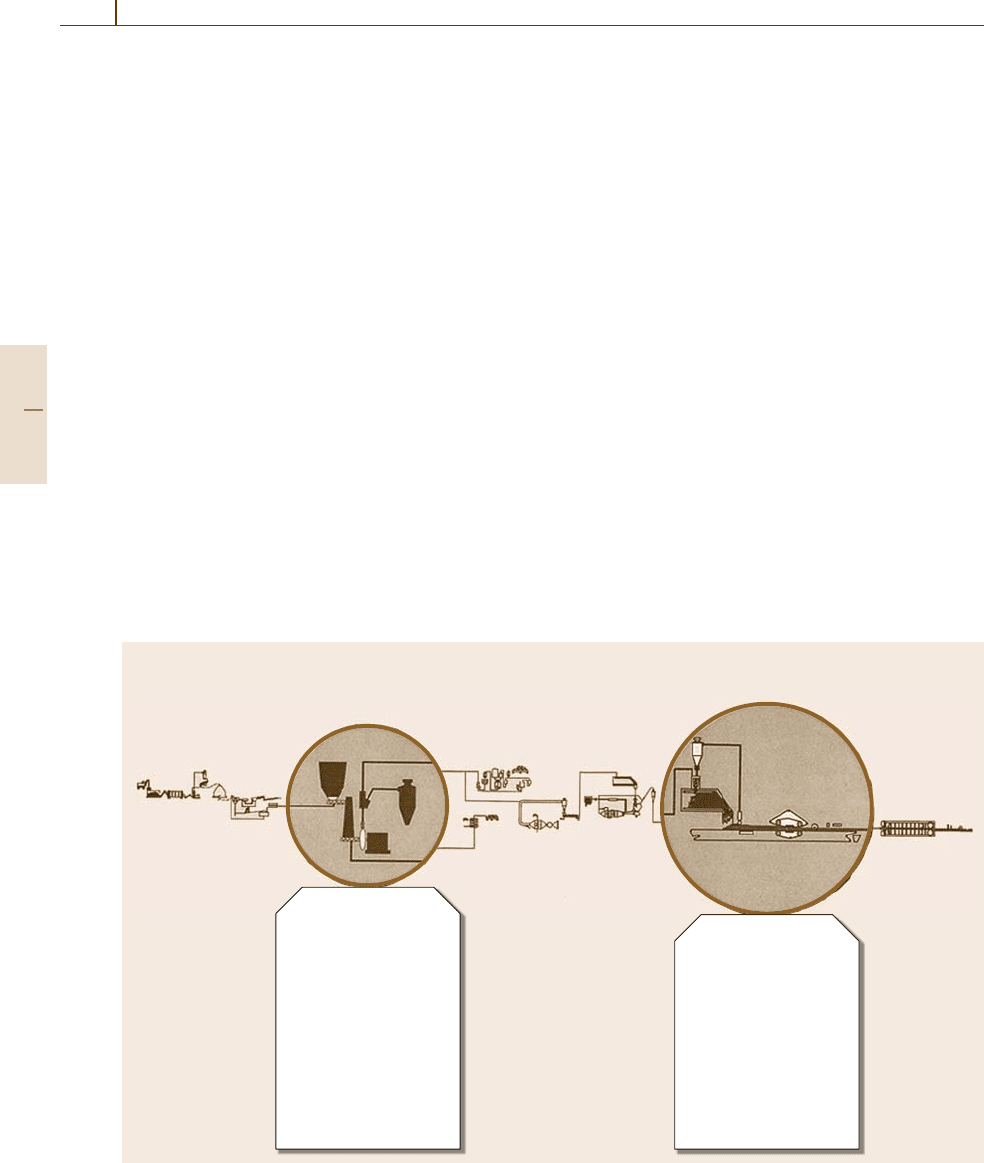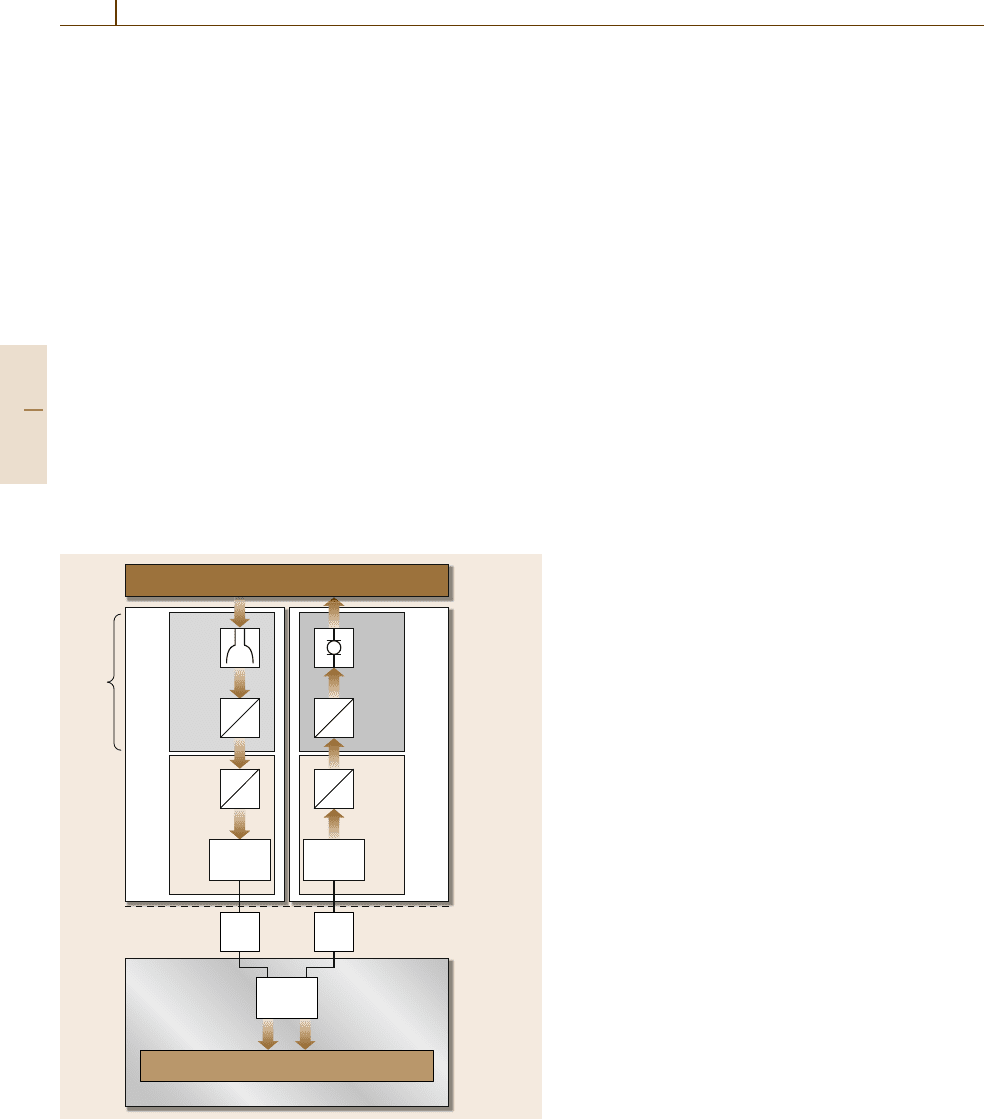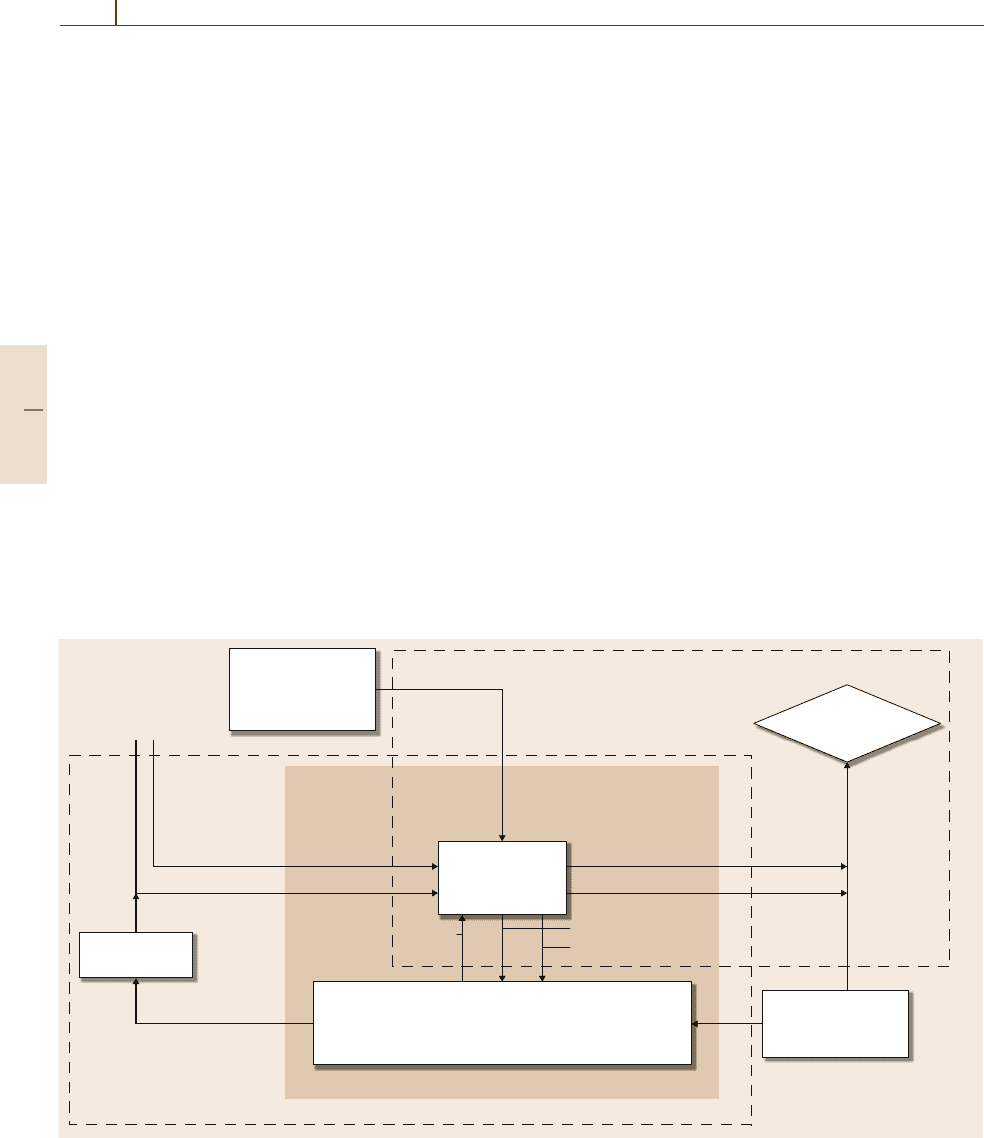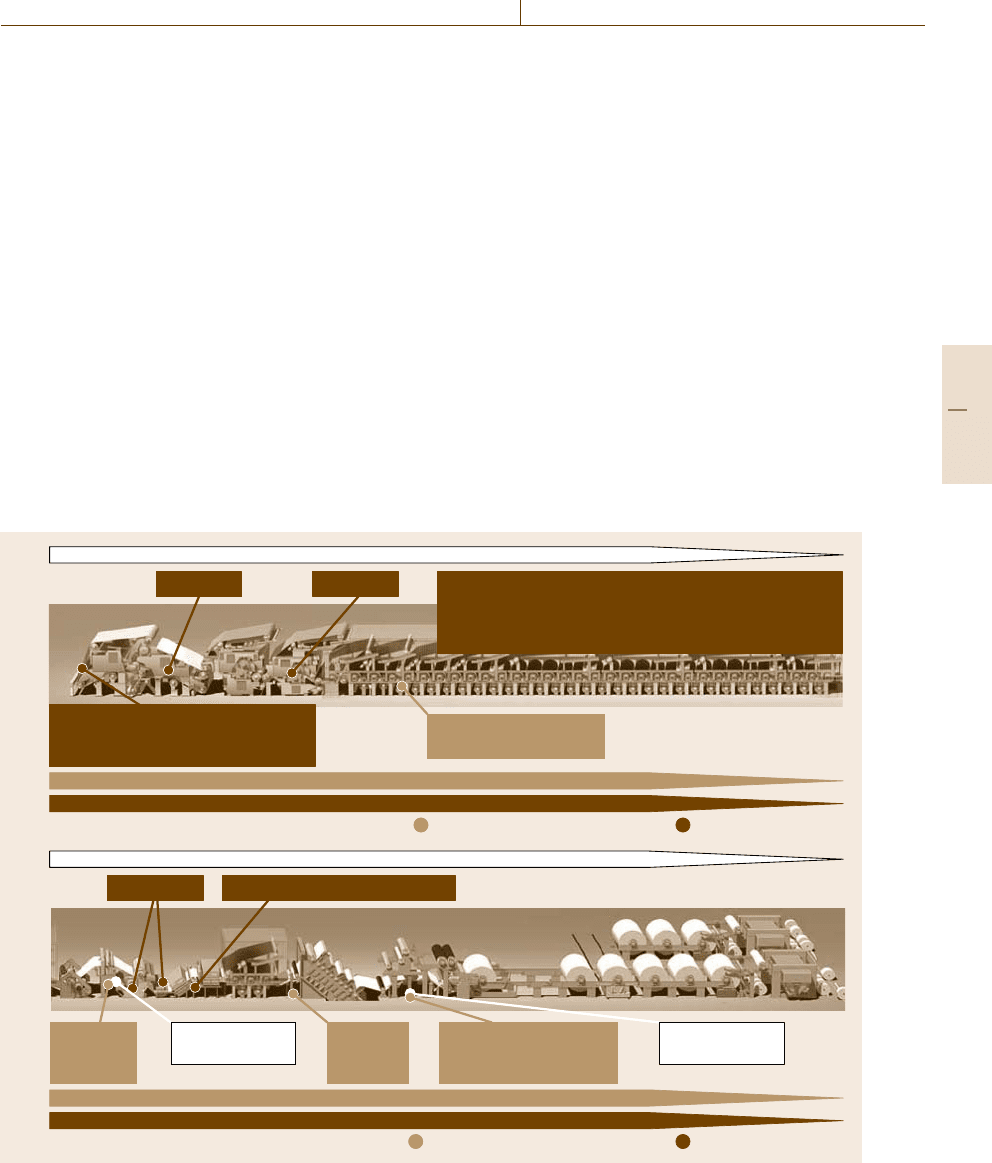Nof S.Y. Springer Handbook of Automation
Подождите немного. Документ загружается.


1015
Automation i
58. Automation in the Wood and Paper Industry
Birgit Vogel-Heuser
Plant automation in the timber (wood) industry
and paper industry has many analogies due to
the similar process characteristics, i. e., hybrid
process. From a plant automation point of view
these industries are challenging because of their
technical requirements. The USA is the largest
producer of paper and paperboard. In a census
by the America Census Bureau, the paper industry
is placed 7 among 21 different industry groups,
with 6% of the total value of product shipments
for the years 2005 and 2006 [58.1]. China, as the
second largest paper producer after the USA, is
expecting a growth rate of 12.4% per annum (for
the forecast from 1990 to 2010) [58.2]. The German
woodworking machinery sector, with more than
26% of the world market share, had a € 3.4 billion
turnover in 2006 and 72% export quota [58.3].
In 2006, the German print and paper industry
grew by more than 7%, to € 8.5 billion and more
than 84% export quota ([58.4], more details
in [58.5]). This chapter will not only highlight the
specific requirements from a technical point of
view but also from the marketing point of view.
Observations from these two points of view will
lead to a heterogeneous automation system with
58.1 Background Development
and Theory ..........................................1015
58.2 Application Example, Guidelines,
and Techniques....................................1018
58.2.1 Timber Industry ...........................1018
58.2.2 Paper-Making Industry .................1023
58.3 Emerging Trends, Open Challenges.........1024
References ..................................................1025
proprietary devices for real-time and machinery-
safety-related tasks, and standard devices for
the rest. Both industries belong to plant man-
ufacturing industries with their typical business
characteristics. Automation in this field is technol-
ogy driven and its importance is growing because
more functionalities are being implemented using
automation software to increase systems flex-
ibility. The interface from automation level to
enterprise resource planning (ERP)systemsisbe-
ing standardized in international manufacturing
companies. Engineering is the key factor for im-
provement that needs to be considered in the
coming years, and therefore also modularity and
reusability where applicable.
58.1 Background Development and Theory
Both processes considered in this chapter are character-
ized by a large number of interrelated but independent
processing steps as well as complex control parameters.
Despite narrow limits and sophisticated process control,
inhomogeneous properties of raw materials will cause
variations in product quality. These variations cannot be
measured directlyat thetime ofproduction and can only
be determined subsequently by destructive testing.
An overview of the requirements of process au-
tomation in plant manufacturing industry is provided in
Table 58.1.
The criteria can be structured according to pro-
cess requirements, automation system architecture, and
project. A process automation system controls a type
of process, e.g., batch, continuous,ordiscrete.Some-
times processes are composed of different process types
and are then known as hybrid process. Both processes
discussed in this chapter are hybrid process.Hybrid pro-
cesses require different control strategies and therefore
also different modeling notations, e.g., block diagrams
(continuous) or state charts (batch). Both processes de-
mand a hybrid automation system architecture.
Part F 58

1016 Part F Industrial Automation
Table 58.1 Overview of the requirements of process automation
Categories/criteria Functionality/notation aspects
Process (hybrid) Batch (continuous) Transfer functions, block diagrams, differential equation
Discrete Status model, flow chart, continuous function chart, Petri net
Real time Hard real-time and event-controlled system, synchronized drive
Reliability Mapping of reliability aspects (failure mode and effects analysis:
FMEA, fault tree analysis: FTA)
Automation system Implementation Programming language (C, IEC 61131-3, PEARL)
(heterogeneous) Operation system [proprietary real-time operating system (RTOS
proprietary)], Windows CE or XT
Hardware platform Programmable logic controller (PLC), distributed control system
(DCS), personal computer (PC), microcontroller
System architecture
heterogeneous
Central, decentralized, distributed
Human–machine
interface (HMI)
PC-based standard HMI tools and proprietary tools for fast trending
of process data
Specific requirements for both considered processes
in terms of process automation are:
1. Wood, as the input material, fluctuates strongly due
to the environment.
2. The required mechanical construction relies on
heavy machinery.
3. They have hard and fast real-time requirements for
the control of central machinery with a large num-
ber of control loops, which does not allow the use of
one standard automation device, for example, a pro-
grammable logic controller (PLC) or a decentralized
control system (DCS). As an example, during par-
ticle board manufacturing in a hydraulic press, up
to 350 closed-loop controllers need to run within
10–20 ms cycle time.
4. Both timber and paper plants can consist of
3000–6000 analogue or digital inputs and outputs
that are connected via a fieldbus. A paper plant
needs to control up to 3500 control loops using
10–20 central processing units (CPUs) (PLCsor
DCSs) that communicate via Ethernet-based bus
systems.
5. The huge number of analogue control loopsin a ma-
chine, in combination with requirements for fast
real-time operation, results in the use of specific au-
tomation solutions. In the timber industry a versa
module eurobus (VMEbus)-based control system is
used, whereas in the paper(making) industry, de-
centralized control systems (DCS) with proprietary
automation devices are used.
6. Worldwide environmental conditions lead to differ-
ent automation architectures, i.e., decentralized and
centralized design.
7. Consideration of both cross section and longitudinal
section in control is required. The width ofa pressed
board is up to 2.9 m and in a paper machine up to
11m, therefore the control and operation task has to
deal with these two dimensions.
8. The need for precise synchronization between sev-
eral drives in the machine, else the paper may
be ripped, the timber mat may be ripped or com-
pressed, or the steel belt of the hydraulic press may
be damaged, thus causing damage to the surface of
the panels. Speed of production depends strongly
on product thickness, and ranges from 300 mm/s
to 1.5m/s in the timber industry and up to 25 m/s
in the paper industry. Older solutions used vertical
shafts to synchronize the drives accurately.
9. Continuous production around the clock, 365days
a year, demands high availability of plant automa-
tion system, i.e., about 90% in the timber industry
and 99.9% in the paper industry.
10. Plant automation can automate almost 100% of
tasks, but some important measurements such as
moisture can still not be measured precisely, while
other values such as internal bonding and bending
strength are only available through laboratory ex-
periments such as destructive testing.
11. Implementation of closed-loop controllers for mat
weight or square weight, moisture, temperature, and
thickness is required. Quality criteria for the sur-
Part F 58.1

Automation in the Wood and Paper Industry 58.1 Background Development and Theory 1017
Table 58.2 Languages of the IEC 61131-3 standard
Name/Functionality Application
Ladder logic/circuit diagram On/off, lamps
Instruction list/assembler type Time-critical modules
Function block language/Boolean operations
and functions
Interlocking, controller, reusable functions,
communication
Sequential function chart/state diagram Sequences
Structured text/higher programming language Controller, technological functions
face structure include color and gloss in the paper
industry and varnishing in the timber industry.
12. From the control-theoretic point of view, today both
processes still lack a method that can model the
whole process and the central machinery, i. e., the
continuous hydraulic press in the timber industry
and the paper machine in the paper industry. A first
attempt to develop a model for the central ma-
chine has been made for the timber industry [58.6].
A method to model the process has not yet been de-
veloped due to lack of information concerning the
process. Support from the operator and technolo-
gist is needed to bridge this gap, and to do this they
would need, for example, a fast trending tool (sam-
ple time 10 ms for 450 analogue inputs) to analyze
and optimize control loops in the entire machine or
process.
After the discussion of technical requirements the
typical market requirements should be mentioned.
The company- and/or product-specific technological
knowhow for both considered domains are of great
value. The market is very competitive, which is why
technological knowhow is kept within different pro-
duction companies. Technological feedback to the
machinery supplier is weak and therefore it is difficult
to achieve technical control improvement. Suppliers are
mostly situated in high-wage countries but the mar-
ket is global, with growing competition from low-wage
countries, therefore engineering efficiency and reduced
engineering times are important for suppliers. Addi-
tionally, reduced start-up times and improved plant
reliability are growing challenges in every part of the
world. This means that engineering processes need to be
optimized through modularity and reuse, as well as data
integration along the engineering lifecycle. Modularity
and reusability in modeling and simulation provide the
opportunity to increase software quality while reducing
start-up time.
During the design of each plant location, various
requirements need to be taken into account, regard-
ing: standards, type, and stability of power supply from
power companies; ground connection; and the different
qualifications of operator and service personnel.
Due to the availability requirement (see item 9
above) and the protection of technological knowhow
while optimizing production, there is a need to provide
maintainable and adaptable systems for the worldwide
market. As far as possible standardized automation sys-
tems should be used, i.e., PLCs in the timber industry
and DCSs in the paper industry.
The end customer usually specifies the brand of
PLC, human–machine interface (HMI), or DCS,and
sometimes also the drives used (if technologically pos-
sible). PLC and DCS systems are programmed accord-
ing to the International Electrotechnical Commission
(IEC) 61131-3 standards (Table 58.2). Customers in the
USA prefer ladder logic as the programming language
whenever possible. Technologically complex functions
will be encapsulated in function blocks. However, stan-
dard PLCsandDCSs are not appropriate for fast
real-time requirements and they can be manipulated by
end customers; this should not be allowed as they are
complex devices and there is the risk of machine haz-
ards. This is why heterogeneous automation systems
are standard in both industries. These heterogeneous
systems consist of standard devices, standard HMIs,
and fieldbus solutions, enriched with domain- or even
company-specific solutions for fast real-time control.
The important difference between the two industries is
that the requirement for intrinsic safety is more relevant
to the paper industry compared with the timber indus-
try. The intrinsic safety requirement has a strong impact
on the selection of appropriate equipment, especially
sensors and actuators as well as fieldbus solutions.
Some green-field plants for the timber industry
include glue production and/or paper machinesthat pro-
duce paper necessary for lamination.
Part F 58.1

1018 Part F Industrial Automation
Most machinery will be shipped in parts and is only
commissioned on site, therefore machines or machine
components will only be tested at the supplier’s site.
The final test is necessary after commissioning on site.
Training of maintenance personnel and operators
takes place during commissioning and start-up. Oper-
ator training systems (OTS), which include simulation
of the process, will be developed in the near future.
58.2 Application Example, Guidelines, and Techniques
As discussed, the requirements of the timber and paper
industries are similar. This Chapter will first explain the
continuous hydraulic press as an application example
to show these requirements in more detail and appro-
priate automation solutions. After that, one solution for
a paper machine will be introduced to highlight the sim-
ilarities in terms of requirements and solutions.
58.2.1 Timber Industry
The production of fiber boards in the timber industry is
a hybrid production process which generates a product
(wooden panels) that has to meet many quality require-
ments. The thickness and density of the board or the
consistency of the material are target values that need
to be controlled within the tight intervals. The process
Storage,
debarking
Chip
washing
...
Squeeze out water
Steam supply to digester
Filling level of digester
Digester temperature
Digester steam pressure
Cooking time
Chip quantity
Paraffin supply
Refiner power consumption
Refiner temperature
Refiner steam pressure
Refiner grinding gap
Refiner disc age
Blowout valve outlet
pH value of fibers
Glue quantity ...
...
Fibre discharge quantity
Spreading height
Height of scalping roll
Forming belt speed
Mat weight per unit area
Mat moisture
Spreading width
Prepress pressures
Prepress gap
Mat density
Spray water quantity
Height of mat
Mat temperature
Sprayer height
Mat rejection ...
Defibration
and gluing
Glue
preparation
Fibre preparation Matforming Hot-
pressing
Paraffin
preparation
Fibre
drying
Hogging,
Sifting,
Bunker
Fig. 58.1 Overview of the fiber board production process (after [58.7])
consists of multiple steps where wood as the input ma-
terial is prepared (Fig.58.1). In the subsequent steps,
the fiber mat is formedthrough continuouspressing pro-
cess, heated, hardened, and sawn into discrete boards.
Wood is anatural material thatis stronglyinfluenced
by temperature and humidity conditions. The input ma-
terial’s characteristics for the process varies widely.
The most costly piece of equipment to acquire and
operate is the hydraulic press. It usually determines
the maximum capacity of the production line [58.8].
The simplified press principle is described as follows.
For the finished board, the material (already mixed
with glue) has to be pressed with a specific pressure
to obtain a certain thickness that is related to a set
value.Wood is a natural materialwith underlying strong
disturbing influences such as temperature or humidity
Part F 58.2

Automation in the Wood and Paper Industry 58.2 Application Example, Guidelines, and Techniques 1019
conditions. Thereby the characteristic of the input ma-
terial to the press varies widely and cannot be measured
with sufficient accuracy for automatic control. Hence
the operator should be able to influence the automatic
control strongly in order to compensate for such influ-
ences, based on his experience. The operator must be
able to recognize that the situation is no longer in the
range of the selected recipe and that he has to react by
Sys_01
Pressure profile Distance profile
d
0
S
L
S
R
S
–
0
Inclination
250
GIC
4R
GIC
3R
GIC
2R
GIC
1R
Frame 5
Frame 4
Frame 3
Frame 1
Frame 2
200
150
100
50
0
31
28
25
22
19
Sys_02
Sys_03
Sys_04
Sys_05
Sys_06
Sys_07
Sys_08
Sys_09
Sys_010
Sys_01
Sys_03 middle: 220.361
Sys_02
Sys_03
Sys_04
Sys_05
Sys_06
Sys_07
Sys_08
Sys_09
Sys_010
Right
Middle
b)
a)
GIC
5L
Y4HR
PIC
Y4HR
G
G
Y4R
G
Y4R
PIC
Y4HR
P
Y4R
P
G
Y4L
PIC
Y4L
Y4L
P
Y4HL
Y4HL
PIC
Y4HL
P
Y4M
PIC
Y4M
G
Y4M
P
GIC
5R
Fig. 58.2 (a) Process and instrumentation diagram of a continuous thermohydraulic press (only distance and pressure
control, working direction from left to right).
(b) Pressure and distance profile of a specific hydraulic press in 3-D; x-axis
shows working direction from left to right, y-axis displays pressure profile (left) and distance profile (right) (after [58.9])
changing the distance or pressure parameters in a spe-
cific frame or group of frames (Fig. 58.2a). Therefore
the operator needs a good overview of the real values of
pressure and distance in cross-section and longitudinal
directions (Fig.58.2b).
Inclination of the press, which would produce an
improper board, can be monitored on the distance
profile (Fig.58.2b right, section 6 slight inclination).
Part F 58.2

1020 Part F Industrial Automation
Torsion of the press table would be identified easily
using this presentation. It is possible to identify if the
pressure is too high along and/or across the press us-
ing the pressure profile (Fig. 58.2b left). The shape
allows evaluation of whether the mat will be pressed
regularly and symmetrically (across the cross section).
Due to technical requirements a maximum pressure
is set in order to achieve the thickness of the mater-
ial. Distance control is realized by several hydraulic
systems that consist of pressure transmitter and pro-
portional valve with position sensor. One frame may
consist of five hydraulic systems. The distance is meas-
ured on the left and right edge of the frame. A press
may have up to 70 or more frames. Therefore, up to
350 pressure values and roughly 140 distance values,
all with a spatial relation to each other, need to be
controlled and displayed. The process and instrumen-
tation diagram for five frames (Fig.58.2a) shows the
hydraulic cylinders, the pressure measurement, and the
distance measurement. Real-time requirements for the
entire loop need to be taken into account (Fig.58.2a).
Bus
coupler
BusBus
Automation device
PLC
Trans-
ducer
Trans-
mitter
Trans-
mitter
=P
=I
=A
=D
Bus
coupler
=P
=I
=A
=D
5 ms
Pressure transmitterI/O-module (bus)
I/O-module (bus)
Actuator
(proportional valve)
up to 75 ms
2 ms
≈20 ms
≈1–5 ms≈1–5 ms
Servo-
motor
Bus
adapter
Process variable
Fig. 58.3 System components of the control loop that needs to be
considered for (hydraulic press) cycle time calculation. I/O –int-
put/output
The controllers are more or less simple proportional–
integral–differential (PID) controllers with filters or
nested PID controllers. Complexity depends on their
interdependency. Hydraulic systems are mechanically
coupled to a thick steel plate to heat the mat so that
the glue will harden. Besides the pressure control and
distance control, temperature control and controllers to
synchronize different drives at the inlet and the outlet
of the press are also included. These drives need to be
synchronized with the different forming linedrives (mat
forming and prepress) to avoid material problems in the
press inlet.
Additionally the upper and lower steel belts need to
be controlled depending on the position of the material
in the press during first inlet or product changes. At the
outlet of the press, synchronization between the cut-to-
size saw and the cooling and stacking line is required.
The endless board needs to be cut into pieces at high
speed, e.g., 1.5m/s. In the timber industry a cut-to-size
saw is included for this task. Additional controllers in
the forming line or press may be added depending on
product requirements and the speed of the production
process.
Figure 58.3 shows the usual time delays in the en-
tire control cycle from data measurement to its effective
influence on the process. It is necessary to reduce the
cycle time for each distance controller in the controller
itself to under 20ms as hydraulic systems are highly
dynamic, especially when the press is operated at top
speed. In addition, synchronization between different
frames is required if switch to another control mode is
necessary.
Currently there is one supplier who provides
a method to calculate the tension in the heating plate.
The calculation is done by a machine-safety-related
controller based on a finite-element calculation in the
automation system.
Specific process control systems, which depends
on the supplier’s chosen solution, e.g., Motorola and
VMEbus-based or personal computer (PC)-based sys-
tems with real-time operating system (RTOS), are
needed to fulfill the strict time requirement. Only one
supplier delivers a PLC solution, which needs less cal-
culation power for a continuous press because it uses
a different mechanical concept.
All distance control needs a data delay less than
10–20ms in order to optimize the control loops for thin
board. In orderto optimizea controller, itis necessaryto
use a data sampling rate that is 5–10 times faster. This
results in an optimized data gathering strategy and the
development of proprietary trending systems [58.10].
Part F 58.2

Automation in the Wood and Paper Industry 58.2 Application Example, Guidelines, and Techniques 1021
Classically, HMI trending functionality is limited to the
fastest sample time of 3 s or even slower because they
focus on long-term trending. PLCs are connected with
an Ethernet-based network (Fig.58.4). Sensors and ac-
tuators are connected with a fieldbus system to ensure
deterministic behavior. The cut-to-size saw is realized
on PLCs with controllers for servo drives, or on more
or less computer numerical control (CNC)-type devices
to enable the required high speed.
Due to customer requirements in plant operation,
such as long mean time between failures (MTBF), plant
maintenance should be carried out by their plant service
personnel. They should have the possibility to manip-
ulate the PLC program within certain limits and to
continue the optimization of processes. Therefore PLC
is the preferred automation approach. The customer can
specify the PLC supplier and bus systems supplier ac-
cording to the market shares in his company and/or
country, the service structure of the PLC supplier, and
the skills of his maintenance personnel.
It is a marketing advantage to implement all control
functionality on PLC. Due to the growth in system ma-
nipulation, a new challenge for PLC is emerging: the
ability to track operator input and manipulations made
on the PLC so that improper manipulations that may
Statistical process (quality)
control (entire plant)
ERP-
interface
Fast trending
press control
Forming line/
press
Forming line
control
Material
preparation
HMIHMI HMI
Forming line/
press
HMI
Forming line/
press
HMI
HMI for
recipe
input
Tren-
ding
MES
Press
forming line
process net
(TCP/IP)
Press control
distance/pressure
PLC preparation
PLC PLC press
(S7) (S7)(S7)
Modem
remote
maintenance
Modem
remote
maintenance
Press control
VMEbus
based
or PC based
FieldbusFieldbusFieldbusFieldbus
Fig. 58.4 Automation architecture (example from one supplier). TCP/IP – transmission control protocol/Internet proto-
col (MES – manufacturing execution system)
cause hazards can be detected and tracked. Password
protection alone is not sufficient.
Regarding safety requirements, a strategy to over-
come loss of power or press stoppage with material
in the press is required because the material may start
burning after a long time. Uninterruptible power sup-
ply (UPS) and emergency power supply are standard
equipment.
The cooling and stacking line (sanding and trim-
ming of particle boards) is needed to cool down
the panel and prepare it for the finishing line with
lamination or paneldivision,sorting, and packing.Inter-
mediate and delivery storages in timber industry often
follow a simple but chaotic storage strategy. However,
tracking and tracing of boards is becoming increasingly
important to the customer. For this reason, ERP and
production management are becoming more important
and a more precise storage system is needed. Board
handling is often realized by using forklift trucks. The
boards are chaotically stacked in a building until the
truck from thecustomer arrives. They are identifiedonly
by a piece of paper with a printed barcode. Due to the
manual handling strategy, tracking of faulty material
is nearly impossible. Two strategies will be discussed
and evaluated later (Sect. 58.2): radiofrequency identi-
Part F 58.2

1022 Part F Industrial Automation
fication (RFID) of every board and global positioning
system (GPS) detection of every stack.
There are also automated intermediate storage sys-
tems that allow handling of different board sizes on
a mobile electrically powered rail-bound device using
steel pallets [58.13]. The material flow is tracked and
the product data are available. In production of thin
medium-density fiber (MDF), board pallets need to be
equipped with top and bottom protection panels to keep
the product flat and protect its surface.
The quality of the board is not only influenced
by the press but in all sections of the plant, particu-
larly by the properties of the wood mixture and glue
used [58.14]. The plant sections involved in the entire
manufacturing process – starting with the hogged chip
manufacturing, flaking or defibrating, drying, blending,
straining, mat forming, up to prepressing and pressing
sections – are all interdependent and, like the properties
of the raw materials used, are subject to fluctuations.
There are more than 100 parameters that have vari-
ous intensities of effects on a plant’s productivity and
the quality of the product (Fig. 58.5). These parameters
are input values for a process model based on a sta-
tistical algorithm [the three-stage least-squares (3SLS)
algorithm [58.15,16]].
Optimization
cost (Y) → min
Q
nom
(t+1)< Q
pred
(X(t))+Y
opt
(t+1)) +S
pred
(x(t),Y
opt
(t+1))
Q
nom
(t+1)
< Q
pred
(t)+S
pred
(t)
Q
pred
(t): prediction of quality parameter
S
pred
(t): statistical safety reserve
X(t): (quality relevant) process parameter
Y(t): control parameter
Predictor
(process model)
Controller
Process optimization
Model-based (quality) predictive process control
Online quality control
Nom. value storage
Y
nom
(0)
Q
nom
Data storage
X(t–1), X(t–2), ...
Y(t–1), Y(t–2), ...
Q(t–1), Q(t–2), ...
Y
nom
(t+1) = Y
opt
(t+1)
Q
pred
(X(t), Y
opt
(t+1))
S
pred
(X(t), Y
opt
(t+1))
Y
opt
(t+1)
Fig. 58.5 Global control loop using model-based quality-predictive and cost-optimized process control (after [58.11,12])
Prerequisites for the analysis of data detailing the
production history of the product, so-called material
tracking and correspondingly time-correlated process
data, need to be calculated. First implementations of
a model-based quality-prediction and cost-optimization
process control are running successfully [58.11,12].
The quality of relevant process data and control
parameters are taken into account to predict the result-
ing quality. Optimized process settings Y
opt
for control
parameters Y are calculated to ensure that nominal re-
quired quality in terms of costs is met
cost(Y) →Minimum
under the condition
Q
nom
(t +1)
< Q
pred
X(t), Y
opt
(t +1)
+S
pred
X(t), Y
opt
(t +1)
and
Q
nom
(t +1)
> Q
pred
X(t), Y
opt
(t +1)
−S
pred
X(t), Y
opt
(t +1)
.
To close the loop, these optimized process settings are
entered as new nominal values for the control param-
eters.
Part F 58.2

Automation in the Wood and Paper Industry 58.2 Application Example, Guidelines, and Techniques 1023
58.2.2 Paper-Making Industry
Heterogeneous automation systems are implemented in
the paper industry to control force, torque, temperature,
moisture, and vibration. Required reliability is 0.9999
(24h/365 days per year). An overview of process sec-
tions, controllers, and most importantly sensors is given
in Fig. 58.6 (working direction: left to right, with the
process divided into two figures). The paper machine is
a device for continuously forming, dewatering, press-
ing, and drying a web of paper fibers [58.18].
The automation system is mainly realized using
a DCS system. In the given example, the automation
system was being realized using PCS 7 Siemens based
on the 400 CPUs. The connection to the sensors and
actuators is realized using the PROFIBUS DP field-
bus. Specific automation devices are implemented for
cross-section control and transmission control. Most
measuring devices, e.g., gloss, moisture, caliper and
basis weight, and color, are equipped with their own au-
Wet end control
Stock consistency; extender; retention;
workload; gas (machine longitudinal)
Scan
Moisture temperature
a)
b)
Scanner
Grammage , strip weight
moisture, gloss, caliper
One side
scanner
Moisture
Scanner
Moisture
grammage
Longitudinal control
Closed-loop control walls; thick-matter flow regulator
grammage, separation of steam pressure; coordinated
change of speed, moisture; production output maximization
Grammage
Coat weight Selective elimination of wet strips
Moisture
Track inspection
system
Track inspection
system
Fig. 58.6 Example of a paper machine: process overview with sensors and actuators (after [58.17])
tomation device and will be connected with a controller
area network bus (CANbus) to the cross-section con-
trol and over a measurement server (PC)totheHMI.
Voith, for example, developed its own weight profile
control system software named Profilmatic. Profilmatic
cross-direction control software continuously and au-
tomatically aligns each actuator against its respective
measurement position from the downstream scanner.
An automapping algorithm monitors the movement of
a normal profile control and aligns the cross-direction
measurement data boxes against the actuator control
zones. Each control output array compares the ac-
tual profile change against the expected profile change.
A software model continuously updates the process-
mapping model using the difference between measured
and expected response.
Model-based soft sensors deliver high-quality data
for superior longitudinal control of the paper machine.
Similar to in the wood industry, a multivariate statistical
approach is implemented to forecast, for example, the
Part F 58.2

1024 Part F Industrial Automation
weight profile at the end of the paper machine. Some
basic constraints for the implementation of statistical
process (quality) control in paper industry are given
in [58.12], e.g.,
this assumes that all of the important variables are
measured in a timely manner ... Another point to
consider is the sampling frequency. Generally, the
more variability in a material, the more often it
should be sampled.
Blatzheim gave an example of the benefit of such
system: 15–16km of waste material reduction was
achieved after implementing this system, corresponding
to an approximate increase of 200 000 of sellable paper
per year.
Laukkanen mentioned OTS and appropriate work-
flow guidelines as being one of the keys to reduce
commissioning and start-up, especially abroad [58.3].
Through the engineering life cycle, depending
on the project phase, different tools and methods
are used. In the worst case, the corresponding data
have to be re-entered during the transition from one
phase to the next because there are no appropri-
ate interfaces between the individual tools. The ideal
is to strive for a higher-level tool that consistently
provides all system information in a model and en-
ables the design to be realized both at an abstract
level and in a conventional environment (e.g., electri-
cal engineering computer aided engineering (E-CAE),
IEC 61131-3).
58.3 Emerging Trends, Open Challenges
There are many open challenges in the timber and paper
industries. Some will be discussed in this section, i.e.,
engineering lifecycle and data integration, reduction
of complexity for operators, improvement of operator
training, as well as evaluation of new technologies.
Open challenges are to increase engineering ef-
ficiency while reducing costs and start-up time by
applying modularity andreuse. Communicationis a ma-
jor factor to consider when improving engineering
quality because different disciplines such as sales, tech-
nology, mechanical engineering (including hydraulic),
electrical engineering, and computer science are in-
volved through different phases in the engineering
process. Communication could be supported by a com-
prehensive model. Unfortunately modeling of hybrid
systems in process automation is still a field for
research and development, especially for reuse and
modularity, and when the target group is engineers
or technicians coming from different disciplines. One
promising approach is to apply a comprehensive mod-
eling notation such as the systems modeling language
(SysML) [58.19] that is based on the unified modeling
language (UML) and developed for systems engineer-
ing. This basically solves the deficiencies of UML for
automation, i.e., modeling of hardware aspects, inte-
gration, and tracking of requirements. The advantage
of UML in terms of supporting modularity through an
object-oriented mechanism is fully available. The task
is to evaluate SysML in terms of ease of application by
engineers and technicians in automation depending on
the availability of strong tools. One of the first steps
to integrate modeling into IEC 61131-3 is already in
progress in a research and development (R&D) project
in Germany. Various UML diagrams are implemented
in one of the market leading IEC 61131-3 tools [58.20].
Presenting the modules throughout the engineering life
cycle from customers’ requirements to operation is still
not solved and will not only be a task for research
but also for the development department of leading au-
tomation companies. Plant manufacturing companies
need an easy way to evaluate whether a new plant con-
cept could be realized by reusing existing modules or
to determine the number of new modules that need
to be developed. Data integration throughout the en-
gineering life cycle is theoretically solved but still far
away from realization in the applied tools. Coupling of
computer-aided engineering (CAE) system on the basis
of a tool-to-tool interface is not sufficient for the two
considered industries.
There is also huge potential for cost saving during
start-up by integrating engineering data into an ERP
system, and offshoring in a global market. Additional
elaboration on logistics, e.g., just-in-time machine or
component to site, is needed. Today mainly mechan-
ical construction has been subject to offshoring. This
will change during the next few years. A lot of chal-
lenges for the engineering workflow will consequently
be affected.
Operation and maintenance, which is challenging
to improve, is also a very important phase in the en-
gineering life cycle. Application of three-dimensional
(3-D) visualization can successfully reduce complexity
Part F 58.3
